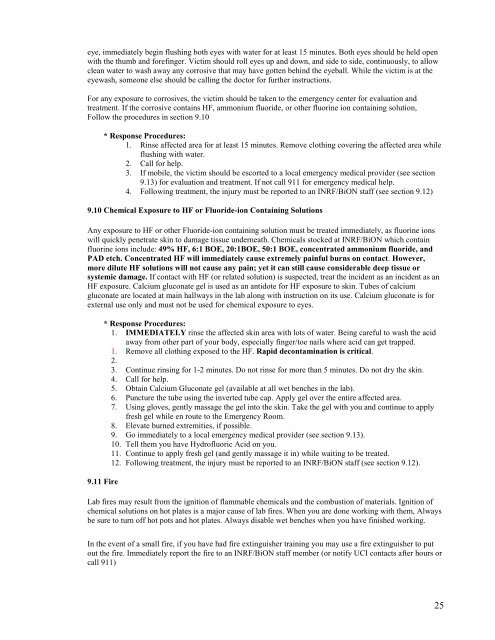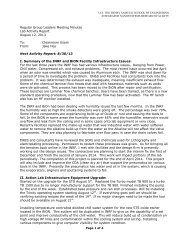Download Lab Safety Manual - Integrated Nanosystems Research ...
Download Lab Safety Manual - Integrated Nanosystems Research ...
Download Lab Safety Manual - Integrated Nanosystems Research ...
You also want an ePaper? Increase the reach of your titles
YUMPU automatically turns print PDFs into web optimized ePapers that Google loves.
eye, immediately begin flushing both eyes with water for at least 15 minutes. Both eyes should be held open<br />
with the thumb and forefinger. Victim should roll eyes up and down, and side to side, continuously, to allow<br />
clean water to wash away any corrosive that may have gotten behind the eyeball. While the victim is at the<br />
eyewash, someone else should be calling the doctor for further instructions.<br />
For any exposure to corrosives, the victim should be taken to the emergency center for evaluation and<br />
treatment. If the corrosive contains HF, ammonium fluoride, or other fluorine ion containing solution,<br />
Follow the procedures in section 9.10<br />
* Response Procedures:<br />
1. Rinse affected area for at least 15 minutes. Remove clothing covering the affected area while<br />
flushing with water.<br />
2. Call for help.<br />
3. If mobile, the victim should be escorted to a local emergency medical provider (see section<br />
9.13) for evaluation and treatment. If not call 911 for emergency medical help.<br />
4. Following treatment, the injury must be reported to an INRF/BiON staff (see section 9.12)<br />
9.10 Chemical Exposure to HF or Fluoride-ion Containing Solutions<br />
Any exposure to HF or other Fluoride-ion containing solution must be treated immediately, as fluorine ions<br />
will quickly penetrate skin to damage tissue underneath. Chemicals stocked at INRF/BiON which contain<br />
fluorine ions include: 49% HF, 6:1 BOE, 20:1BOE, 50:1 BOE, concentrated ammonium fluoride, and<br />
PAD etch. Concentrated HF will immediately cause extremely painful burns on contact. However,<br />
more dilute HF solutions will not cause any pain; yet it can still cause considerable deep tissue or<br />
systemic damage. If contact with HF (or related solution) is suspected, treat the incident as an incident as an<br />
HF exposure. Calcium gluconate gel is used as an antidote for HF exposure to skin. Tubes of calcium<br />
gluconate are located at main hallways in the lab along with instruction on its use. Calcium gluconate is for<br />
external use only and must not be used for chemical exposure to eyes.<br />
9.11 Fire<br />
* Response Procedures:<br />
1. IMMEDIATELY rinse the affected skin area with lots of water. Being careful to wash the acid<br />
away from other part of your body, especially finger/toe nails where acid can get trapped.<br />
1. Remove all clothing exposed to the HF. Rapid decontamination is critical.<br />
2.<br />
3. Continue rinsing for 1-2 minutes. Do not rinse for more than 5 minutes. Do not dry the skin.<br />
4. Call for help.<br />
5. Obtain Calcium Gluconate gel (available at all wet benches in the lab).<br />
6. Puncture the tube using the inverted tube cap. Apply gel over the entire affected area.<br />
7. Using gloves, gently massage the gel into the skin. Take the gel with you and continue to apply<br />
fresh gel while en route to the Emergency Room.<br />
8. Elevate burned extremities, if possible.<br />
9. Go immediately to a local emergency medical provider (see section 9.13).<br />
10. Tell them you have Hydrofluoric Acid on you.<br />
11. Continue to apply fresh gel (and gently massage it in) while waiting to be treated.<br />
12. Following treatment, the injury must be reported to an INRF/BiON staff (see section 9.12).<br />
<strong>Lab</strong> fires may result from the ignition of flammable chemicals and the combustion of materials. Ignition of<br />
chemical solutions on hot plates is a major cause of lab fires. When you are done working with them, Always<br />
be sure to turn off hot pots and hot plates. Always disable wet benches when you have finished working.<br />
In the event of a small fire, if you have had fire extinguisher training you may use a fire extinguisher to put<br />
out the fire. Immediately report the fire to an INRF/BiON staff member (or notify UCI contacts after hours or<br />
call 911)<br />
25



